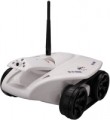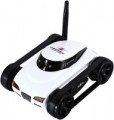Age
The minimum age for which this radio-controlled model is suitable. These recommendations are rather conditional, but it is still not recommended to deviate from them. "Adult" models 14+ with many adjustments, moving parts and power simply will not be able to master the baby. At the same time, models for the younger age category may not be interesting and boring for older children.
Maximum movement speed
The maximum speed at which a tank can move on level ground. Unlike real tanks, radio-controlled models are mostly designed for indoor use, where there is simply nowhere to accelerate strongly. Therefore, the maximum speed in most cases is small. This means that the main point that, when choosing according to this parameter, it makes sense to take into account is the age of the future owner: for young children, high speed (even by the standards of tanks) is all the more unnecessary, but for a grown-up “tanker” you can already choose a model faster .
Battery capacity
The capacity of the battery supplied with the electric motor model (see "Motor"). Indicated only for variants using original batteries (see "Battery type"), measured in ampere-hours: 1 Ah corresponds to the capacity at which the battery is capable of delivering a current of 1 A for 1 hour.
The higher the battery capacity, the longer, usually, the tank is able to work without recharging. However, the practical time of operation on a charge is largely determined by other characteristics of the machine — scale (see above), weight, model and engine power, the presence of additional features such as turret rotation or various effects, etc. Therefore, in most cases, this parameter plays a purely reference role and in fact can only be useful when buying a new battery as a spare or replacement — capacity data will allow you to evaluate the characteristics of the new battery and its general suitability for this model. By this indicator, only models that do not have any significant differences in other characteristics can be compared with each other.
Battery voltage
The operating voltage of the battery supplied with the tank. For models for AA and AAA cells (see “Battery Type”), it is not indicated — the specification of these cells assumes a common voltage standard, about 1.5 V. In other cases, battery voltage data does not play a significant role in everyday use, but may be useful , if you need to pick up a charger, a spare battery or a battery to replace a damaged one, but you do not have data on the battery model (see below).
Battery type
The type of power source required for the operation of the tank (the power supply for the remote control is indicated separately, see below). Note that such sources are required not only for models with electric motors (see "Engine") — any radio-controlled car needs electricity at least for the operation of the radio signal receiver.
— Li-Ion. Batteries made using lithium-ion technology and not belonging to any of the universal standard sizes (like AA, see below). This technology makes it possible to create batteries that are smaller and lighter than the "nickel" varieties described below; in addition, lithium-ion batteries are practically not subject to the “memory effect”, are easy to use and charge quite quickly. Their disadvantages include a higher price and less resistance to high and low temperatures than those of the same "nickel".
— Li-pol. Further development of the lithium-ion technology described above. Lithium-polymer batteries have an even higher charge density, which made it possible to achieve compact dimensions; on the other hand, the disadvantages in the form of high cost and sensitivity to extreme temperatures are more pronounced in them.
— Ni-Cd. The oldest of the technologies used in the batteries of modern radio-controlled tanks. Nickel-cadmium batteries have low cost, good reliability, resistance to low and high temperatures, and high charging speed. All this makes this option well suited for radio-controlled cars — es...pecially large-scale, with an abundance of additional features that require a lot of power. At the same time, such batteries are not without serious drawbacks. Chief among these is the "memory effect"; it manifests itself in the fact that when charging an incompletely discharged battery, its capacity decreases. However, subject to the rules of operation (quite simple), this effect can be reduced to almost zero.
— Ni-Mh. Technology designed to overcome the disadvantages of nickel-cadmium batteries (see above). Nickel-metal hydride batteries have the same advantages as their predecessors — reliability, resistance to adverse temperatures, high charging speed; at the same time, they are practically devoid of the "memory effect" and are considered safer from an environmental point of view. Of the shortcomings, only specific storage requirements can be noted: such batteries cannot be kept completely discharged for a long time.
— AA. Unlike all previous designations, this one does not describe the technology for manufacturing batteries, but the standard size. AA is a small battery, colloquially referred to as "finger-type". Their key difference from all the types of batteries described above is their versatility: such batteries are replaceable and are widely used in a wide variety of electronic devices. At the same time, not only rechargeable batteries are produced in this standard size, but also disposable cells, which gives you the choice: either to buy batteries every time as needed for relatively little money, or to pay a large amount for batteries once, but not to spend money in the future. Further expanding the choice is that AA elements have different characteristics and price, but are completely interchangeable. The main practical advantage over the original batteries is the ability to quickly replace dead batteries: they are sold in almost all stores with “household trifles”, and the process itself usually takes less than a couple of minutes. On the other hand, the power of such a power supply is quite modest, so it is found in models of a relatively small scale, and the batteries themselves usually need quite a lot — about 6 – 8 pcs. In some models, AA elements may be included in the package, but most often the owner of the machine has to buy them on their own.
Battery model
Model of the original battery (see "Battery Type") used to power the tank. Most often, such a battery is supplied with the “apparatus”. Data on the battery model may be needed if it is out of order and needs to be replaced, when looking for a spare battery or when selecting a charger (usually, charging capabilities are already provided in the standard package, but it is possible that a separate device will be required).
Operating time
Operating time of a tank with an electric motor (see "Engine") on one battery charge or on one set of batteries. Usually, this parameter is indicated for perfect operating conditions: on a flat surface, at low speed, without using additional functions (shooting, turret rotation, effects, etc.), and for models on AA batteries (see "Battery type") — also with high quality and good capacity of these batteries. The conditions of actual operation are different, respectively, and the operating time may differ markedly from that stated in the specifications. Nevertheless, this parameter characterizes the battery life of the car quite well and quite allows you to compare different models with each other.
Range
The maximum distance from the remote control to the tank, which retains the possibility of full control of the model. Note that the documentation usually indicates the “perfect” range — in the absence of interference and obstacles in the signal path, the use of high-quality batteries, etc.; therefore, in fact this figure may be lower. At the same time, this characteristic makes it possible to estimate the range of the remote control, including and compared to other models.
The greater the radius of action, the further you can let go of the model from the remote control, the less often you have to move to keep control. At the same time, the speeds of modern radio-controlled tanks are generally low, staying close is not difficult, and driving a car over long distances is usually not required (especially since at such distances it can be hardly noticeable). Therefore, even the most advanced models with analogue control standards (see "Radio channel frequency") are rarely equipped with remote controls with a range of more than a couple of tens of metres. With digital channels (see ibid.), the situation is different: these standards, by definition, have a rather large "range", exceeding the mentioned 20 – 30 m, so the range is usually not indicated for them at all — it is assumed that it is, by definition, sufficient for regular ways to use the tank.
Dimensions
General dimensions of the tank. Note that the length is indicated taking into account the cannon pointing forward (this clarification is relevant for rotating turrets, see above). But the height may not take into account a bendable antenna or removable design elements (such as a tanker figurine in a hatch).

